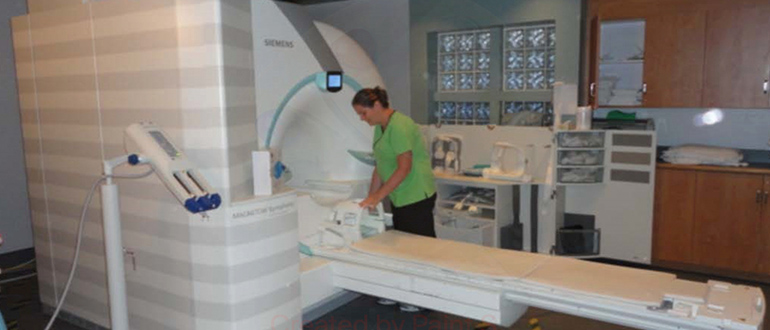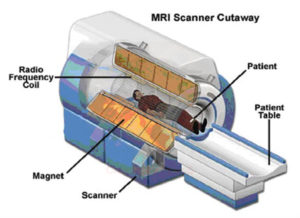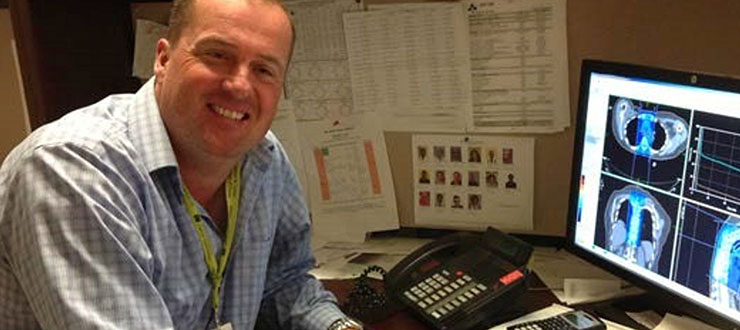toh
Magnetic Resonance Imaging (MRI)

- An MRI (or magnetic resonance imaging) scan is a test that uses magnetics, radio waves, and a computer to produce images of the body.
- The MRI scanner is a tube surrounded by a giant circular magnet.(see image) You are placed on a moveable bed that is inserted into the
- The magnet provides a strong magnetic field that interacts with the tissue in your
- This interaction produces a faint signal that is picked up by the MRI This information is sent to a computer, and an image is produced.
- The image produced by MRI is high quality and can detect very small changes within the body.
- For some MRI procedures, you may be required to have a small injection of contrast media to see your body parts better.
How does it work?
- MRI uses magnetic fields, radio waves and computers to generate images of the tissues within your body.
- The computer processes the signals generated from the body to form the MR images. Different tissue types appear as different shades on the MR images.
- The radiologist (specialist in medical imaging) will then view the MR images and create a report.

The Magnet
- The primary magnet is a permanent and powerful magnet.
- A strong magnetic field is always present in the magnet room.
- Care must always be taken to make sure that certain metals (those containing iron) must not be brought into the room.
- Those objects are attracted to the magnet and may become loose and harm individuals and equipment.
The Coils
- Next to the part of your body being imaged are the coils.
- There are coils made for shoulders, knees, and other body parts.
- The coils will send and receive the signals that the computer turns to images.
What is it used for?
An MRI scan can be used to find and see tissue changes throughout the body.
What is the difference between an MRI and a CT Scan?
- Both MRI and CT scans give exact 2D or 3D images. They use a computer system to create slices of images of areas of the body being scanned.
- The main difference between CT and MRI, CT uses x-rays to obtain imaging which will be shown as a picture using a computing system.
Is it a problem if I am breast-feeding or pregnant?
It is better to avoid having an MRI during the early stages of pregnancy, even though there is no proof of harm from MRI to the baby.
Mothers who are breastfeeding should be given the opportunity to decide whether to continue breast-feeding or temporarily stop after receiving IV contrast. Less than 1% of the contrast dose is passed into breast milk and less than 1% of that is absorbed into the breast milk will be absorbed by an infant. Reports show that it is safe for the mother and infant to continue breastfeeding after receiving contrast.
If you remain concerned about any effects to your child, you may stop breastfeeding for 24 hours while continuing to express. You can either discard the breast milk from both breasts during that period or you may wish to use a breast pump to collect milk to feed your child later. Any further questions should be directed to your physician or the lactation consultant of TOH.
How to prepare for your MRI
- You may take your regular medication. Please bring a list of all your current medication.
- If diabetic, take insulin as directed. You can have a light meal after taking insulin.
- If you have allergies to any medication, food or other things, tell the staff before the test.
- If you are pregnant or think you might be, tell the staff before the test.
- If you know or think that you will receive an IV contrast injection, for the 24 -hour period leading up to the time of your MRI exam, please drink a total of 8 glasses of water. You will be instructed to drink additional water after the exam. This will help flush the IV contrast out of your system.
- You do not need a full bladder for this scan, so you can urinate before the exam. If you are on fluid restrictions, please contact the MRI booking office for additional instructions.
Are there any risks from the examination?
For most people, there is no danger with having an MRI scan. The MRI machine uses a strong magnetic field, which will move objects made with iron or steel. Metal objects can interfere with an MRI exam. (A secure place to store your valuables will be provided):
Please remove the following:
- Coins
- Jewelry, hair pins, metal zippers
- Hearing Aids
- Cards with magnetic stripes (i.e. Credit Cards)
- Watches
- Keys
- Dentures or partial plates
The MRI machine uses a strong magnetic field, which will move objects made with iron or steel, let us know if you have:
- A pacemaker, internal defibrillators or artificial heart valves
- Aneurysm clips
- Cochlear implants
- History of metal in the eye
- A neuro-stimulator (Tens-unit)
- Metal implants
- An implanted drug infusion device
- Tattoos – Dyes used may contain iron and could heat up during MRI, but this is rarely a problem
In the past all the metallic devices were at high risk but today there are many new implants that may be MRI compatible, and when doing a MRI all devices must have all clinical and manufacturer information to evaluate the safety before doing an MRI.
To see if a MRI is possible to have, you will be asked if you have been injured by bullets or shrapnel or if you who work with metals.
In some cases, it may be necessary for you to have a plain x-ray prior to an MRI to determine if any metal is present.
Some metal implants do not cause problems;
- Most bone and dental implants are not magnetic.
- These include hip and knee replacement, plates, screws, and rods used to treat breaks, and cavity fillings.
How Should I Get Ready for the Exam?
As a rule, please do not bring valuables to your appointment. You will need to remove any metal objects from your body, hair clips, glasses and removable dentures.
It is best to wear clothes without metal zippers or studs. If you are wearing clothing that may interfere with the scan, you will be asked to change into a hospital gown.
You may take your regular medication. Please bring a list of all your current medications to show to the Technologist performing your scan.
What If I’m Having an MRI With Contrast?
There are no special preparations when having an MRI with contrast.
- However, if you are aged 70 or older, or have certain conditions, your doctor will provide our office with current blood work results in order to assess your kidneys’ ability to handle the contrast.
- Those conditions will be discussed at the time of booking and are part of the questionnaire that you will fill on the day of the examination.
- Prior to the examination, a technologist will insert an intravenous (IV) line into a vein in your hand or arm. This will feel much like when you give a blood sample.
- For the procedure, you will be brought into the magnet room, where you will be asked to lie on an imaging table.
- The technologist will leave the room while the MRI procedure takes place. The technologist will be able to see you and speak with you throughout the procedure.
- You will be given something to use that will tell the technologist if a problem should occur.
- The contrast agent will be injected into the IV after some of images are taken.
- When the contrast is injected, it is normal to feel coolness and a flushing sensation for a minute or two. More images will then be taken during or following the injection.
- When the exam is complete, you will be asked to wait in the waiting area for a short period of time before the IV is removed.
- This is to make sure you are observed for 30 minutes after the injection for signs of an allergic reaction.
- Allergic reactions are extremely rare.
May I bring someone to exam?
- Yes, although they will likely have to wait in a waiting room while the procedure is being done
- While your having the procedure, you can talk to technologist at any time.
What’s the procedure like?
- The table and you are positioned inside the opening of the MRI Scanner.
- Small devices that contain coils may be placed around or near your body part that is being studied.
- The technologist will watch you closely and speak to you throughout the study. You will be able to speak with the technologist at any time.
- You will be required to remain as still as possible during the test.
- Sponges and holders may be used to help with this, so you can hold the correct position during imaging.
- When the MRI starts to work, there will be a lot of noise and some knocking sounds. These sounds occur whenever the image is being taken.
What’s the exam like?
- You will be provided earplugs or headphones to help block out the noise.
- Although it’s noisy, an MRI exam does not hurt. The only thing you must do is HOLD STILL.
What happens if I can’t lie still or want to get off the table?
- When you take a picture with a camera, your subject must keep still, or the picture will come out blurry. It’s the same with an MRI machine. If you move, the scan may have to be repeated.
- Each series takes 3 to 5 minutes.
- We will try to make sure that you are comfortable throughout the exam.
- You will be able to talk with the technologist with a call bell and over an intercom at any time during the exam.
Will it hurt?
No. An MRI sends painless magnetic and radio waves through your body to create images. A contrast agent may be used to better see a part of your body. If this is the case, a small needle, called an IV will be inserted into your arm to pass the contrast into your body. This needle will feel the same as when you have a blood sample taken.
I’m having a head scan. Is it possible that I will be able to see outside the magnet during my exam?
Yes. Our MRI systems have a special mirror arrangement that can always allow you to see outside the magnet.
Why does my whole body have to be in the scanner when only scanning my head?
The bore (the inner “doughnut” sized opening) of the magnet is 4 feet in long this is where you are placed for the MRI examination. We get the best images when the body part to be looked at is placed as close to the middle of the magnet bore as possible.
Is the machine open at both ends?
Yes. All MR systems are open at both ends.
Can’t you scan my whole body while I’m in there?
No. MRI is very specific, and we can only image the area that the physician has asked for. We need to focus on that area to make sure that we get the best answer for you and your doctor.
Will I be alone?
You will always be in contact with a technologist. Even when he or she is not in the MRI room, you will be able to talk to him or her by intercom.
The technologist is always able to see you through a large window.
Will I fit?
There are very few patients who will not fit into the MRI machine for an exam.
The machine can accommodate up to 200kg or 440lbs of weight, and the bore (doughnut hole) is 60 cm round.
How long does the MRI take?
The MRI procedure will typically last between 20-60 minutes. Depending upon the area being looked at, the setup of the room and the position of the patient may be different.
Who will perform my exam?
An MRI Technologist will perform your exam. All technologists are highly skilled and have completed courses to perform MRI examination.
Are there any side effects? / Will I feel any different after the exam?
You may feel very well rested since you’ve just been lying on a table and doing absolutely nothing! (In fact, some people even fall asleep during the exam.) Other than that, you’ll feel perfectly normal and can go back to your everyday activities.
If you have further questions about your MRI exam, the MRI technologist or your doctor will be glad to answer them.
There are no known side effects of MRI. There is no radiation and the test has no known long-term effects.
Who looks at the images and when will I get my results?
- A Radiologist, who has been trained in reading these scans, reviews the results of your MRI scan.
- The results cannot be given to you on the day because it takes a relatively long time to review all your images and needs to be compared with any other examinations you may have had.
- You can obtain your results from your ordering physician.
- Your referring physician will receive a report usually within 2 to 7 days of your exam.
Will the results of my scan be kept confidential?
Yes. All hospital staff are bound to confidentiality guidelines and follow strict codes of professional conduct.

- MRI Abdomen and Pelvis
- MR Angiography (MRA)
- MRI Body
- MRI Chest
- MRI Head
- MRI Sinuses
- MRI Spine
- MRI Bones & Joints
- MRI Breast
- Enterography by MRI
- Breast Biopsy by MRI
- Prostate Imaging by MRI
Last updated on: November 10th, 2023


 To reset, hold the Ctrl key, then press 0.
To reset, hold the Ctrl key, then press 0.
